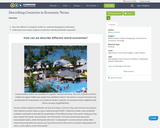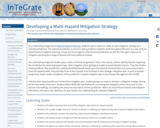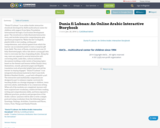
Students will investigate the processes and changes in climate that lead to sinkholes.
- Subject:
- Ecology
- Environmental Science
- Oceanography
- Physical Geography
- Material Type:
- Lesson Plan
- Author:
- Lora Gibbons
- Date Added:
- 03/26/2019

Students will investigate the processes and changes in climate that lead to sinkholes.

Students learn about local and planetary physical geography / geology, toponymy, planetary landing site selection and cartography. The students learn a complex process of landscape evaluation and city planning, based on the interpretation of photomaps or digital terrain models.

CultureTalk - Arab World features native speakers from across the Arabic-speaking world giving filmed interviews, in Arabic and sometimes English, on selected topics. Text-based translations and transcriptions are often provided as downloadable documents for most Arabic videos. The videos engage a number of region/country-specific topics, including cultural traditions, religion, politics, and sports.

CultureTalk - Arab World features native speakers from across the Arabic-speaking world giving filmed interviews, in Arabic and sometimes English, on selected topics. Text-based translations and transcriptions are often provided as downloadable documents for most Arabic videos. The videos engage a number of region/country-specific topics, including cultural traditions, religion, politics, and sports.

This project is an attempt to build a comprehensive database of Arabic place names that covers the entire world, not just place names in the Arabic speaking world. The place names are proofread carefully to ensure adherence to the rules of hamza orthography, something often ignored in most publications. The database gives the correct name in Arabic script, its name in English or transliteration, spelling variants, and common errors in spelling. Frequency of variants is also given.

Activities

Describe different sociological models for understanding global stratificationUnderstand how studies of global stratification identify worldwide inequalities

This lesson provides experience working on a real-life scenario by allowing students the opportunity to use topographic maps to design a hiking trail system based on access from road, range of habitats, and other specified criteria. They will also complete a data sheet and produce an informational brochure.

In this Physical Geography Lab, students are responsible for designing a simple biological community.
(Note: this resource was added to OER Commons as part of a batch upload of over 2,200 records. If you notice an issue with the quality of the metadata, please let us know by using the 'report' button and we will flag it for consideration.)

As a culminating assignment in Natural Hazards Planning, students work in teams to create 15-year mitigation strategy for a selected jurisdiction using the FEMA 386 methodology for prioritizing mitigation options.
(Note: this resource was added to OER Commons as part of a batch upload of over 2,200 records. If you notice an issue with the quality of the metadata, please let us know by using the 'report' button and we will flag it for consideration.)

The lesson content focuses on designing investigations concerning the notion of scale through a series of investigations on their campus. The overarching goal is to foster a connection to the earth through an investigation of the local environment.

An Introduction to Soil Science
Short Description:
Written entirely by members of the Canadian Society of Soil Science, "Digging into Canadian Soils: An Introduction to Soil Science" provides an introduction to the core disciplines of soil science, and introduces the concepts and vocabulary needed by students just beginning their soil science journey. The textbook provides supplementary materials that are specific to regions in Canada, or may be of specific interest beyond what might be considered introductory soil science material. Importantly, the textbook also is intended to introduce students to the Canadian System of Soil Classification by providing examples from across the length and breadth of the world’s second largest country, and to the Canadian Society of Soil Science, whose members share a common passion for soil science and are keen to share and instill this passion with students across Canada.
Long Description:
Written, reviewed and edited by members of the Canadian Society of Soil Science, Digging into Canadian Soils: An Introduction to Soil Science provides an introduction to the core disciplines of soil science (pedology, soil biology and microbiology, physics, chemistry, fertility and nutrient cycling, and management), and introduces the concepts and vocabulary needed by students just beginning their soil science journey. The textbook is appropriate for use in a number of disciplines, including environmental and agricultural sciences, as well as related geology, geography and natural resources engineering disciplines.
Chapters within the textbook are presented in three sections according to the content and level of the complexity. The first section of the book, Digging In, introduces core disciplines in a series of chapters written by authors whose research expertise informs the chapter content. Supplementary materials that are specific to regions in Canada are presented in chapters within a second section, Digging Across Canada. The third section, Digging Deeper, provides in-depth overview of some topics beyond what is considered core soil science disciplinary material, and may be appropriate for upper level soil science or related discipline courses. The textbook includes an extensive glossary that is accessible via in-text links. Importantly, the textbook is intended also to introduce students to the Canadian System of Soil Classification by providing examples from across the length and breadth of the world’s second largest country, and to the Canadian Society of Soil Science, whose members share a common passion for soil science and are keen to share and instill this passion with students across Canada.
Word Count: 182572
ISBN: 978-0-88880-668-0
(Note: This resource's metadata has been created automatically by reformatting and/or combining the information that the author initially provided as part of a bulk import process.)

Geographic information systems (GIS), once used predominantly by experts in cartography and computer programming, have become pervasive in everyday business and consumer use. This unit explores GIS in general as a technology about which much more can be learned, and it also explores applications of that technology. Students experience GIS technology through the use of Google Earth on the environmental topic of plastics in the ocean in an area known as the Great Pacific Garbage Patch. The use of this topic in GIS makes the unit multidisciplinary, incorporating the physics of ocean currents, the chemistry associated with pollutant degradation and chemical sorption to organic-rich plastics, and ecological impact to aquatic biota.

The disappearance of bees will have tremendous impact upon the way we live according to scientists in this segment from Nature.

The purpose of this resource is to use a land cover type map to make environmentally sound decisions.

Ponavljanje teme Suvremena Afrika za 6. razred osnovne škola.

This jigsaw activity introduces students with Arctic weather data using a role-playing activity that has students read and interpret graphs while considering the optimal time to plan a research mission to the Arctic.

“Dunia Fi Lubnan” is an online Arabic interactive storybook developed by Alefb multicultural center for children with support from Qatar Foundation International through a Curriculum Development grant.
The storybook is a fully illustrated interactive story, and includes interactive comprehension quiz questions prompted by "Nahla the bee" in English, playful drills to test reading, writing and comprehension, and cultural games from which the learner can accumulate points to earn a surprise gift from Alefb. The story of Dunia, stretched out over 22 fully illustrated pages, tells a tale about a young girl who tries to overcome her fear of speaking Arabic. Along the way, users are exposed to several interactive self-correcting drills, audio files, cultural authentic documents tackling a wide variety of learning topics based on the themes and lessons within Dunia's story. Animations, sounds, glossaries pages and English translation tools all provide helpful hints and aid the learner in staying engaged. “Dunia Fi Lubnan” is an integrated educational material in that it uses both Modern Standard Arabic, الفصحى and colloquial العامية.
The interactive and multimedia components are designed in part to enhance regular curricula for teaching Arabic as a foreign language to children, teens and even adults, individually or in a classroom setting.
When all of the modules are completed, learners will have acquired new vocabulary, reinforced their reading, writing and comprehension skills, and been exposed to different practices, products and perspectives of the Arabic culture. Learners will be able to write a simple postcard using vocabulary from the following topics: Greetings, Feelings, Activities, Countries and Places, Colors, Food, Things and Family/Friends.

The history of earthquakes in the San Francisco Bay area is plotted on a digital map and analyzed in this video segment adapted from NOVA.

In essay format, this textbook considers examples of various sub-categories of Geography in combination with five regions of the Eastern World.
Created for GEOGR 1105 - Eastern World Geography at the College of DuPage. This resource will be updated as needed. For the most recent version, visit: https://cod.pressbooks.pub/easternworlddailyreadingsgeography/